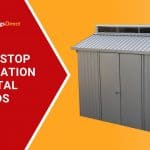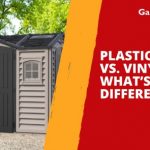Jump to:
Plastic sheds often get a bad rap because people don’t know enough about them. Despite the term “plastic,” they’re not merely composed of basic materials. Instead, they’re made of vinyl or high-density polyethylene (HDPE). These synthetic polymers boast durability and UV resistance while remaining lightweight and portable.
In this guide, we’ll outline their pros and cons. By the end of this post, we’ll let you decide if this type of storage solution is any good.
The Pros
Despite misconceptions, plastic garden sheds offer notable benefits that shouldn’t be overlooked. Let’s explore how these structures stand out in terms of advantages.
Maintenance free
Plastic sheds offer the significant advantage of being nearly maintenance-free. Unlike wooden sheds, you won’t need to replace roof felt, sand, paint, or treat them for rot and pests. Rust is also not a concern compared to their metal counterparts.
The structures are easy to assemble and create a tight seal. This keeps water out and protects your tools and shed from damage. Since there’s no dampness or rot, pests like rodents won’t be able to get in. They have nowhere to enter, with no gaps in the walls or base. This also means you won’t need to spend money on wood treatment products.
Cleaning the shed occasionally will help it last longer, but it’s a simple task.
Weather-resistant
Plastic sheds are built to withstand various weather conditions. They’re made from materials like HDPE, designed to endure extreme temperatures. This resilience is especially beneficial in climates with unpredictable weather patterns. Plus, they resist sunlight, snow, rain, wind, and temperature changes, ensuring year-round durability.
Durability
Nowadays, plastic sheds are made with sturdy materials that ensure durability and resilience. Panels crafted from HDPE and PVC offer strength and weather resistance. Some models even feature reinforced steel structures for added robustness.
Additionally, modern resin models resist fading over time. Thick panels offer insulation, regulate temperature, and prevent dampness.
Stylish
Plastic sheds now offer style along with functionality. Their design has improved dramatically. You can now have features like shutters, arched windows, and imitation slate roofs. This means you can find something that fits your garden without giving up on style.
Portability
One advantage of plastic sheds is their portability. Due to their lightweight construction, they’re easy to move around when needed. This offers flexibility in organising your outdoor space or adapting to changing needs.
Thinking of repositioning the shed to a different area of your garden? Perhaps you wish to take it with you when you move houses? Either way, the lightweight nature of a plastic shed makes it a convenient option. This means you can easily disassemble and transport it, unlike a wood or metal type.
Low risk of pest infestation
Unlike timber sheds, plastic sheds aren’t vulnerable to pest infestations. This advantage eliminates the need for costly and time-consuming pest control measures. You can enjoy peace of mind, knowing that your items will remain safe from damage caused by pests. This also ensures a cleaner and more secure storage environment.
Eco-friendly options
Some manufacturers offer plastic sheds made from recycled materials. This method contributes to sustainability efforts by reducing waste and promoting recycling.
By choosing an eco-friendly plastic shed, you can minimise your environmental footprint. Even better, make a positive impact on the planet! Combined with durability and functionality, it aligns with your eco-conscious values, to add.
Value for money
Plastic sheds provide excellent value considering their practicality. They are lightweight, durable, and weather-resistant, making them a reliable choice. Some may cost as much as metal sheds, but their quality and long-term benefits justify the price. Despite initial moulding costs, durable vinyl plastic ensures lasting quality. This makes them a worthwhile investment overall.
The Cons
But, like all things, we don’t just see this type of garden shed with rosy-tinted sunglasses. There are still some cons that people will have questions about.
Security risks
Some remain concerned about security. Although sturdy, plastic sheds may be less secure than timber ones. If a break-in does happen, replacing parts can add to the cost. Bolt-fastenings and heavy-duty shed locks can enhance security. They especially come in handy in sheds with reinforced steel frames.
May not handle strong winds
One common question about plastic sheds is whether they can withstand strong winds. While there are stories of them being blown away, the stories are mostly exaggerated.
Weaker models might struggle in severe weather. However, modern ones with HDPE plastic and reinforced steel frames are highly durable. To give you an idea, look at the BillyOh Ashford Apex.
You get what you’re given
Plastic sheds aren’t easily customisable. Their surfaces aren’t conducive to painting or attaching additional features like shingles. While you can drill holes for shelves, adding shingles or painting isn’t recommended. Modifying them could compromise their structural integrity or void warranties. On the bright side, this also means less maintenance.
Limited shed insulation
Limited insulation is a downside of plastic sheds. Because of their material, they may struggle with temperature control. This makes them less suitable for extreme weather in return.
To protect sensitive items, you might need to add insulation, such as foam panels or blankets. If temperature control is essential, assess your storage needs and insulation requirements carefully.
Structural strength considerations
Plastic sheds, while durable, may lack the robustness of wood or metal counterparts. Due to their lightweight build, they can bend or warp under heavy loads or in windy or snowy areas.
Other materials might be preferable if you require higher structural integrity. Assess your needs and environmental factors to ensure your shed meets the demands.
Vulnerability to fading
While plastic sheds are fade-resistant, they may still experience some fading over time. Despite the UV-resistant materials, prolonged exposure to the sun’s rays can be the enemy. For one, it can gradually impact the colour vibrancy of the shed. This can result in a less visually appealing appearance.
Place the shed in a shaded area or use UV-protective coatings or awnings for shade to minimise this. Regular cleaning and maintenance can also help maintain its appearance.
Round-up
Plastic sheds offer several advantages, such as low maintenance, durability, and affordability. However, they may have drawbacks like limited customisation and potential fading. Ultimately, your specific needs and preferences depend on whether it’s right for you.
Explore our quality products at Garden Buildings Direct today! Next on your reading list: Lifetime Plastic Sheds: 5 Best Heavy-Duty Plastic Sheds
If you have any further questions, contact us and don’t hesitate to give us a call at 01909 768840.
Shop Plastic Sheds










